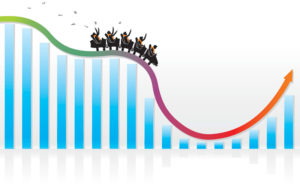Managing Financial Uncertainty
By Jim Terwilliger
 These past several months are unprecedented in modern times. The COVID-19 health crisis came out of nowhere and quickly morphed into a global economic and financial crisis that will take some time to sort out. How much time? No one knows for sure.
These past several months are unprecedented in modern times. The COVID-19 health crisis came out of nowhere and quickly morphed into a global economic and financial crisis that will take some time to sort out. How much time? No one knows for sure.
The impact on the equity markets was swift and deep. Within the first month alone through March 20, the S&P 500 stock index dropped over 30% from its February 2019 all-time high.
How quickly things can change!
Just a few months prior to this, it appeared that the 11-year stock market boom would continue forever. But, of course, it cannot.
First, by their very nature, stocks are volatile. They are also unpredictable. That is why they offer a premium return over bonds, CDs, savings accounts, etc. Quite simply, they embody the ages-old risk-reward relationship. No risk, no reward. Stocks are behaving just the way they are expected to behave.
Second, investing in stocks is a five-to-10-to-15-year (plus) play. Nothing shorter. Investment outcomes should only be measured in such timeframes. Those who measure success or failure in weeks, months or even a handful of years and react to market noise within short timeframes are practicing speculation, not investing.
Finally, stock prices over the long-term are related to the financial strength of the underlying companies. Stock prices, day-to-day, tend to be influenced by stockholder emotions and speculative investing. One can argue that the Dec. 31, 2019 stock prices were over-valued. Today, one can argue that today’s prices are undervalued. There is no way the intrinsic value of companies dropped by over 30% in the one-month timeframe noted above.
So, what is one to do?
• Construct a Plan. I cannot emphasize this enough. Whether it’s saving for a new boat, house, college or retirement, a plan is critical. A plan is based on your goal(s) and time horizon. A plan is a prerequisite to constructing a supportive investment strategy. Investments become the engine that fuels the plan.
• Investment Strategy Design. The first step is to choose an overall ratio of stock holdings to bond/cash holdings consistent with your plan and risk tolerance. Particularly for folks nearing or in retirement, having a reasonable portion in bonds/cash will buffer the portfolio from wild stock market swings, up and down. The next step is to diversify within the stock and bond categories. The key is to have a broad exposure to global asset classes in order to maximize diversification.
• Emergency Fund. This also is critical. All households need a cash emergency fund, apart from goal-related savings/investments, equal to at least three to six months of expenses. This fund must be guarded carefully so that it does not disappear to fund vacations, kitchen and bath renovations, etc. “Emergency” is the operative word here.
• Stick to Your Plan. Once your financial plan and investment strategy are defined and working, stick with it. This is the hard part. It is easy to do when the markets are doing well. Not so, when markets are tanking. If your plan or your circumstances haven’t changed, resist the urge to make drastic changes to your investments in reaction to what the market is doing short term.
This is not a set-it-and-forget-it approach. It is important to rebalance your holdings back to target percentages on a regular basis. We generally recommend annually. Additionally, if your overall stock-to-bond/cash allocation is driven away from target by 10% or more, consider rebalancing before your next scheduled rebalance. Then start the one-year clock again. While rebalancing is counter to what your emotions would lead you to do, it is a disciplined way to consistently sell high and buy low, the holy grail of investing.
“Are you in a wealth accumulation mode? Consider a market meltdown as your friend. While you continue to contribute a given amount, say, monthly to your IRA, 401(k) plan, or investment account, you are buying stocks ‘on sale.’”
• Managing Market Meltdowns. Are you in a wealth accumulation mode? Consider a market meltdown as your friend. While you continue to contribute a given amount, say, monthly to your IRA, 401(k) plan, or investment account, you are buying stocks “on sale.” Each regular contribution purchases more shares vs. what you had been buying prior to the downturn.
Are you retired and in a wealth distribution mode? When you are taking regular distributions, organize your distribution strategy to take only from your bond or cash portions. Leave your stock holdings untouched until the markets recover.
Above all, remember that the world capital markets recover from downturns. It’s all part of the volatility characteristic of stocks. The timing for recovery, of course, is very much dependent on the circumstances. Each event is different.
Trying to manage through good and bad times is a daunting task. Working with a trusted wealth adviser gives you the best chance for a successful outcome.
James Terwilliger, CFP®, is senior vice president, senior planning adviser at CNB Wealth Management, Canandaigua National Bank & Trust Company. He can be reached at 585-419-0670 ext. 50630 or by email at jterwilliger@cnbank.com.
